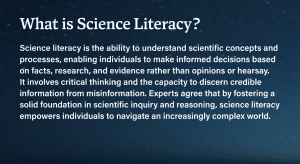Enhancing Literacy in Rural Areas


Efforts to improve scientific knowledge, especially in underserved areas, are increasing as researchers and educators seek to close the gap in science education. Such efforts are especially important in the rural South, where students face significant barriers to learning science, often compounded by economic challenges and limited resources.
To address these challenges, academic researchers at Michigan State University (MSU) have developed a project, in collaboration with historically black institutions Alabama A&M University (AAMU) and Winston-Salem State University (WSSU), to align and high school chemistry and physics curriculum. , Crafting Engaging Science Environments (CESE), is more culturally responsive for students in this area.
“This collaboration represents a breakthrough for scientific research in [AAMU] and progress for Alabama children, especially those who live in rural areas, “Samantha Strachan, EdD, assistant professor and coordinator of the secondary education program at AAMU, said in a statement announcing the project. “Our university will be very involved in implementing a new method that can change the way teachers teach science and how students learn science.”
The environmentally responsive approach to the CESE curriculum integrates students’ cultural backgrounds with everyday experiences in the science curriculum. This approach aims to make education more relevant and engaging, thus encouraging sustained interest in STEM (science, technology, engineering and mathematics) fields, encouraging more students to pursue higher education and jobs in these areas.
Experts agree that abstract STEM concepts are less likely to affect students than hands-on experiments and lessons related to their communities, such as drinking water quality, local energy production, and education. of environment and environment.
CESE’s project-based curriculum aligns with Next Generation Science Standards and allows students to explore and research topics related to their interests and experiences. Examples include physics modules that describe the physics forces and motions involved in dropping and breaking a line, and engineering materials on the principles of sound that go into designing a concert experience. By collecting and analyzing experimental data and ideas, students can see practical applications of science in their lives.
“[CESE] advances science education, and with the collaboration of our partners, we believe it will be the same in the South,” Barbara Schneider, PhD, John A. Hannah University Distinguished Chair in the College of MSU study and principal investigator of the project. , said in a university statement. “As students in the rural South find solutions to important problems in their communities through science education, we hope to see their increased commitment to STEM and desire to pursue science careers.”
Funded by a $7.7 million New Education and Research grant from the United States Department of Education, the project will be rigorously evaluated. To determine the effectiveness of the CESE curriculum in improving academic achievement in the rural South, a five-year randomized controlled trial will involve 4,000 students and 90 teachers from low-income and underrepresented communities. well in Alabama and North Carolina. This study will utilize existing partnerships between AAMU, WSSU, and their local school districts.
The project will include professional development opportunities for teachers,
 provision of curriculum materials and technology tools, and collaboration with technology companies to ensure that students have the necessary tools. This comprehensive approach ensures that students and teachers are well equipped to do this work and use it effectively in their classrooms.
provision of curriculum materials and technology tools, and collaboration with technology companies to ensure that students have the necessary tools. This comprehensive approach ensures that students and teachers are well equipped to do this work and use it effectively in their classrooms.
The CESE curriculum has already shown positive results in Michigan and California, with increased student engagement and higher achievement scores. The hope is that similar success will be seen in the rural South, Schneider said, resulting in more students choosing to pursue science careers. Engaging students in project-based learning helps them build confidence and see themselves as future scientists.
“Teaching and learning science is an important part of preparing the next generation of adults to be active in their families, communities, communities, and the world,” said Lena Walton, PhD, assistant professor of elementary education at AAMU. , said the statement. “This project-based collaborative effort will enhance science education so that students can see its value and applicability even in their lives as non-scientists.”●
#Enhancing #Literacy #Rural #Areas

